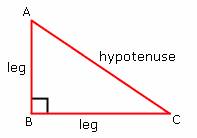Masei- Lines and Angles
"Hashem spoke to Moshe, saying: 'Command the Children of Israel and say to them: When you come to the land of Canaan, this is the land that shall fall to you as an inheritance, the land of Canaan according to its borders. The southern side shall be for you from the Wilderness of Zin at the side of Edom, and the southern border shall be for you from the end of the Salt Sea to the east. The border shall go around for you south of Maaleh-akrabbim, and shall pass toward Zin; and its edges shall be south of Kadesh-barnea; then it shall go out Hazar-addar and pass to Azmon. The border shall go around from Azmon to the stream of Egypt, and its edges shall be to the west. And the western border: It shall be for you the Great Sea and the bounded area; this shall be for you the western border. This shall be for you the northern border: from the Great Sea you shall draw a slanting line for yourselves to Mount Hor. From Mount Hor you shall draw a slanting line to the approach to Hamath, and the edges of the border shall be toward Zedad. The border shall go forth toward Zifron and its edges shall be Hazar-enan; this shall be for you the northern border. You shall draw a slanting line for yourselves as the eastern border from Hazar-enan to Shefam. The border shall descend from Shefam to Riblah, east of Ain; the border shall descend and reach the bank of the Kinnereth Sea to the east. The border shall descend to the Jordan, and its edges shall be the Salt Sea; this shall be the Land for you, according to its borders all around.'" ~Bamidbar 34;1-12
Rashi on Bamidbar 34;7: (one explanation that Rashi gives for this passage)
You shall draw a slanting line: This means, you shall move on a slant to veer from west to north to Mount Hor.
Math Connection:
Lines and angles are amongst the earlier Geometry concepts that are introduced to students towards the middle of elementary school. The idea of angles being measured in degrees is a very abstract concept, but there are basic concepts that relate to angles that are taught early on.
*The point where 2 lines connect is called a vertex.
*When 2 lines connect at a vertex and continue to make a longer, straight line, it's called a straight angle, and it measures 180° (read: "180 degrees").
*When 2 lines connect at a vertex and turn to make an angle that looks like a proper corner, it's called a right angle, and it measures 90°.
*An angle that is greater than 90° is called an obtuse angle.
*An angle that is less than 90° is called an acute angle.
Parsha Connection:
For reference, the red borders on this map of Canaan shows you the borders listed in Bamidbar 34;1-12.
In this week's parsha, we are given the border demarcations for the land of Canaan, which is to be an inheritance to the Children of Israel. The beginning landmarks for the borders are given in such a way that the border is simply drawn by connecting straight lines between listed points, or following a described path between listed points.
However, when we get to certain border descriptions, we are told that "you shall draw a slanting line" between two locations. One of Rashi's explanations on these words is that it is a slanted line between the two directions. In other words, when we are told to travel north, south, east, or west, we automatically picture making a 90° turn, or following a path at 180° degrees. By being told that the line is on a slant in 34;7, for example, we learn that it's not a path straight up from the western point and then turning a 90° corner when you reach the proper location to the north; rather, the border line is an acute angle from the western location of the Great Sea to the northern location of Mount Hor.
An interesting follow-up activity:
A slightly more advance geometry concept is that the shortest distance between two points is in a direct line. A common theme in questions around this concept is to have students calculate distance if you travel from one point to another along two sides of a 90° (A to B and then B to C, above) or if you travel directly between them (along the hypotenuse of the triangle- A to C, above). In our examples in this week's parsha, if we were to create the borders of Canaan by drawing up and over in each place where we are told to draw a slanting line, how much extra land would have been included within the borders? (Extend the triangles outward so that the slanted borders are each the hypotenuse and the new borders would be the legs of the imaginary triangles- then think area calculations. Note that some of the triangles will be narrower than others.)

No comments:
Post a Comment